- Submissions

Full Text
Research & Development in Material Science
Introduction to Molecular Dynamics Simulation of a Cement Paste Structure Including Single Walled Carbon Nanotubes
Anna Lushnikova, Olivier PLE* and Yago De Souza Gomes
Université Savoie Mont-Blanc, France
*Corresponding author: Olivier PLE, Université Savoie Mont-Blanc, CNRS, UMR CNRS 5271, LOCIE, 73370 Le Bourget du Lac, France
Submission: November 10, 2022;Published: November 23, 2022

ISSN: 2576-8840 Volume 18 Issue 2
Abstract
This work analyzed the effect of the addition of single-wall carbon nanotubes (SWCNTs) in cement composites through Molecular Dynamic simulations. To model the atomic structure of the cement composed of a Calcium Silicate Hydrates (C-S-H) gel, Tobermorite 11Å was chosen. SWCNTs type Armchair (3,3) incorporated into the tobermorite structure in four different quantities (0.00%, 1.22%, 2.55% and 4.00% by weight of Tobermorite 11Å) were tested through simulations of applied uniaxial pressure, as well as simulations of applied electrical field, to study the effect of the concentration of carbon nanotubes in the cement composite. Results exhibited a higher tensile strength and a higher Young’s Modulus for the model Tob-CNT(4.00wt%) with values of 14.27GPa and 165.46GPa, respectively, while the model Tob-CNT(2.55wt.%) showed a stronger converse piezoelectric response with a calculated d33 of 8.62pC/N. It is therefore a promising method to develop a “multifunctional smart concrete” that can be designed to provide mechanical resistance, thermal control, self-monitoring and energy management..
Keywords: Carbon nanotubes; Physical properties; Smart cement; Sensor
Introduction
Cementitious composites and concrete, in particular, have been playing a very important role in the last decades, being one of the most used materials for structures until now. Questioning the use of concrete today, researchers have worked to improve the characteristics of cementitious composites, by mixing the cement paste with additives. Therefore, the modern engineering community has shown a lot of interest in the development of civil infrastructure systems with new features for materials such as self-condition monitoring.
New additives are currently being studied and the innovation tends to go towards the nanoscale. Therefore, cement nano-modification allows new structures to be used as a direct additive into the matrix of the cement composite as well as the creation of new superplasticizers with nanoparticles. Carbon allotropes like Carbon Nanotubes (CNTs) are used for this study because they have shown very good mechanical, electrical and thermal properties. The enhanced strength of cementitious materials modified with carbon nanotubes is more widely tested. However, previous studies with carbon nanotubes also identified changes in the piezoelectric values of cement matrix. It is therefore a promising method to develop a “multifunctional smart concrete” that can be designed to provide mechanical resistance, thermal control, self-monitoring and energy management.
According to bibliographic references, a low concentration of CNTs can increase the mechanical properties of cement-based materials [1-7]. Carbon nanotubes also were employed in cementitious materials to induce a piezoresistive effect [8-12]. Azhari F [10] modeled cement-based sensors with carbon nanofibers and carbon nanotubes and reported changes in resistivity, with the best result for the hybrid sensor, containing both carbon nanotubes and carbon nanofibers. Zhao et al. [11] performed experimental works in carbon nanotubes dispersed in cement-sand-based piezoelectric composites with concentrations from 0 to 0.9 vol% (volume percentage) and observed an improvement in the piezoelectric properties, with an optimal value for CNT content of 0.6vol%. Gong et al. [12] prepared cement based piezoelectric composites from Portland cement with the addition of 70vol% of PZT powders and concentrations of modified CNTs varying from 0 to 1.3vol%. They obtained the highest piezoelectric constant d33 of 62pC/N for a 0.3vol% concentration of CNT.
This study deals with numerical simulations. In those simulations, the dynamics occur by the interaction of discrete elements, in our case atoms which are referred as particles. In the case of this study, the number of particles depends on the number of carbon nanotubes embedded into the structure of tobermorite, so it can be various. In our examples, the number of particles is between 9683 and 9899. These simulations are allowed by the evolution of software programs for molecular modelling, a computational tool that increases in time to time its accuracy in representing physical, chemical and biological characteristics of systems built by molecules and atoms in interaction. The piezoelectric effect is the polarization induced by applied strain. When compressing or tensioning, the position of atoms changes within the crystal structure, generating a voltage.
Thuswise, the main purpose of the present work is to establish at the atomic level, an opportunity to investigate mechanical and electrical properties of cement paste structure modification with CNTs.
Numerical Simulation
Tobermorite, a crystalline mineral having a similar structure with C-S-H gel, was chosen in this study, as it is the main constituent and consequently the most representative element of cement paste after hydration. There are some subspecies of tobermorite that are classified by their different interlayer spacing (14Å, 11Å and 9Å) and Tobermorite 11Å is the most used model to describe cement paste in molecular dynamic simulations [13]. Its initial structure is a monoclinic structure with vectors 𝑎=6.735Å, 𝑏=7.385Å, 𝑐=22.487 Å and the angles between vectors 𝛼=90°, 𝛽=90°, 𝛾=123.25° obtained by Merlino [14]. A python code was used to create the initial configuration system. The general triclinic unit cell basis can be represented in a matrix format as follows:

The fractional positions are included in vector format and three loops will extend the positions in cartesian dimensions according to the system size to form a supercell. In this project, tobermorite 11Å supercells of size 5𝑥5𝑥3 with a total number between 9683 and 9899 atoms were used (Figure 1).
Figure 1:Process of creating system configuration.

We consider SWCNTs type Armchair (3,3) with length of approximately 70Å. They were aligned to the z direction. First a vacuum in the structure of tobermorite was created. In our study vacuum means the hole created for implement the insertion nanotube in the structure of tobermorite, in other term, the absence of the atoms in the simulation box keeping the neutral charge of system. It was done by not assigning the unit cells for a giving position in the xy plane, for example, in Figure 2, for the insertion of 1 CNT the unit cells where x=3 and y=3 was ignored in the code. It can be interesting if the geometry of the unit cell, e.g. the cross section is comparable to the hole diameter one wants to use. Other ways of inserting CNT in tobermorite exist, such as the one used by Eftekhari [15], in which a zero-diameter cylindrical hole is gradually indented, pushing the atoms backwards, to avoid bond breaks and bonds formation.
Figure 2:Schematic process of inserting a carbon nanotube into Tobermorite 11Å supercell

Systems with 0.00%, 1.22%, 2.55% and 4.00% of CNT by weight (wt%) of tobermorite 11Å were prepared (Figure 3). Those concentrations are calculated straightforwardly by multiplying the atomic mass by the number of atoms in the system.
Figure 3:Four systems used in the simulations, of the constructed CNT-reinforced Tobermorite 11Å after thermalization.

After preparing an Armchair (3,3) CNT we apply Tersoff potential to rule the interaction between carbon atoms. The same procedure is followed with the supercell of tobermorite 11Å. Interatomic potential energy will result from the sum of all types of atomic interaction, which in our study are described by Buckingham, Stillinger-Weber, core-shell Spring and Coulomb Potential for the atoms within tobermorite structure. Lennard- Jones Potential was used to describe interaction between atoms of tobermorite and CNT [15-17].
Results
Periodic boundary conditions were utilized to mimic a bigger system and avoid the boundary effect. A minimization is performed, followed by an NPT ensemble at zero pressure, 300K and a time step of 1 femtosecond to control temperature and pressure of simulation box.
The Young’s Modulus of the built model is assessed and compared with the literature (Tables 1 & 2). After equilibration of the system, the length of the simulation box in the z direction is saved as the initial length, before starting deformation through a uniaxial tension applied to the structure by constraining one side of the system and deforming the opposite side with a strain rate of 0.00001/fs (Figure 4); [18-22].
Table 1: Calculated young’s modulus of tobermorite 11Å..

Table 2:Calculated young’s modulus of SWCNT.
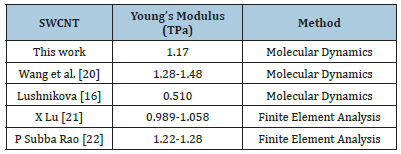
Figure 4:Tobermorite 11Å with 2.55wt.% of CNT tensioned along its longitudinal direction at a) strain = 0.0; b) strain = 0.125; c) strain = 0.15; d) strain = 0.25.
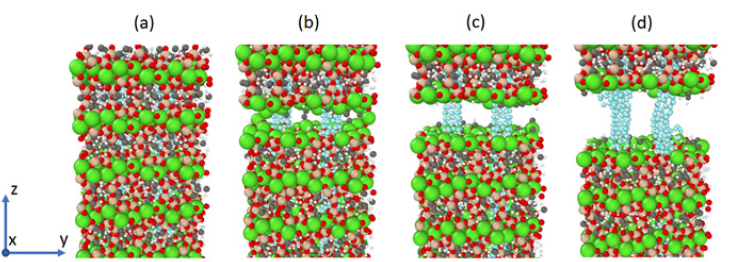
After testing tobermorite 11Å and CNT (3,3) individually, the same tensile test is now imposed to combined tobermorite 11Å + CNT to evaluate the effect of CNT concentration in the tensile resistance of tobermorite 11Å. The results for Young’s Modulus, tensile strength and the evolution of stress due to applied strain for the Tobermorite-CNTs models are presented at Table 3 and Figure 5 respectively. The first peak of stress at 0.1 strain (Figure 5) indicates the breaking of bonds in tobermorite atoms (Figure 4b) then the stress increases again but this time tensioning basically only the CNTs (Figure 4c) until the rupture of CNTs at around 0.25 of strain (Figure 4d).
Table 3:Young’s modulus and tensile strength of tobermorite-CNT samples.
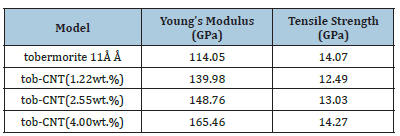
Figure 5:Tensile stress vs strain of tobermorite-CNT in z direction.
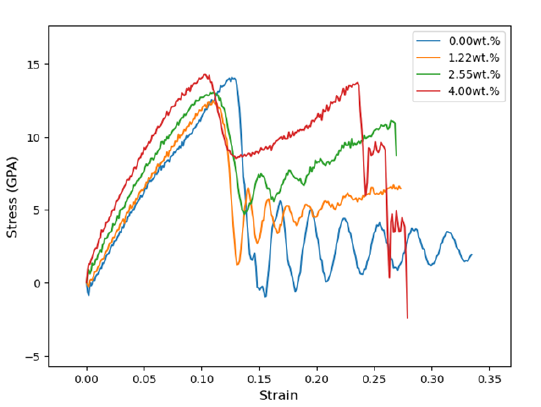
The converse piezoelectric is simulated. After equilibrating the system, the lengths of the simulation box are followed during the application of an external electric field of 250MV/m oriented in the z-direction. The comparison on the evolution of the box length in z direction for the four systems is presented in Figure 6.
Figure 6:Evolution of cell size with different CNT concentrations.
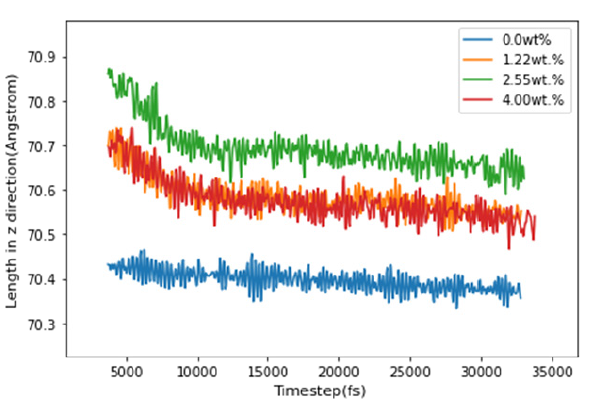
The strain tensor εij was calculated between steps 4,000 and 10,000 of the simulation. The deformation was a result of the application of an electric field of 250MV/m in the z direction. Considering that there was no external stress applied and no temperature increment, the equation of conversed piezoelectric effect in a triclinic structure can be represented by:

Which can be solved for d33 yielding:

Table 4:Piezoelectric constant d33 for each of the four samples.

Conclusion
In this work, the effect of the addition of carbon nanotubes into cement composites was investigated through molecular dynamics simulation, where tobermorite 11Å was chosen to represent C-S-H gel, being combined with single-wall carbon nanotubes type Armchair (3,3). Four different CNTs concentrations by weight of tobermorite were subjected to a tensile test in z direction with a strain rate of 0.00001/ps and, separately, subjected to an electrical field of 250MV/m in z direction.
The tensile stress-strain curves show a higher tensile strength and a higher Young’s Modulus for the model tob-CNT (4.00wt%). The more CNTs are present in the model, the lower the strain in which the sample reaches the first peak, that correspond to the collapse of tobermorite 11Å. The models with CNTs will have more than one peak, as the stress will increase again after the collapse of tobermorite, until the rupture of the carbon nanotubes, which can indicate a more ductile behavior on a large scale. The converse piezoelectric effect was analyzed following the deformation in the simulation box after the applied electrical field. The results showed a stronger converse piezoelectric response for the sample with 2.55wt.% with a d33 of 8.62 pC / N . It is therefore a promising method to develop a “multifunctional smart concrete” that can be designed to provide mechanical resistance, thermal control, selfmonitoring and energy management.
References
- Cerro-Prada E, Pacheco-Torres R, Varela F (2020) Effect of multi-walled carbon nanotubes on strength and electrical properties of cement mortar. Materials 14(1): 1-13.
- Li GY, Wang PM, Zhao X (2005) Mechanical behavior and microstructure of cement composites incorporating surface-treated multi-walled carbon nanotubes. Carbon 43(6): 1239-1245.
- Hawreen A, Bogas JA (2019) Creep, shrinkage and mechanical properties of concrete reinforced with different types of carbon nanotubes. Construction and Building Materials 198: 70-81.
- Lu L, Ouyang D, Xu W (2016) Mechanical properties and durability of ultra-high strength concrete incorporating multi-walled carbon nanotubes. Materials 9(6): 419.
- Hu S, Xu Y, Guo J (2020) Modification effects of carbon nanotube dispersion on the mechanical properties, pore structure, and microstructure of cement mortar. Materials 13(5): 1101.
- Lushnikova A, Zaoui A (2017) Improving mechanical properties of C-S-H from inserted carbon nanotubes. Journal of Physics and Chemistry of Solids 105: 72-80.
- Lushnikova A, Zaoui A (2018) Influence of single-walled carbon nantotubes structure and density on the ductility of cement paste. Construction and Building Materials 172: 86-97.
- Yu X, Kwon E (2009) A carbon nanotube/cement composite with piezoresistive properties. Smart Materials and Structures 18.
- Saafi M, Gullane A, Sadeghi F (2018) Inherently multifunctional geopolymeric cementitious composite as electrical energy storage and self-sensing structural material. Composite Structures 201: 766-778.
- Azhari F, Banthia N (2012) Cement-based sensors with carbon fibers and carbon nanotubes for piezoresistive sensing. Cement and Concrete Composites 34: 866-873.
- Zhao P, Wang S, Wang X (2016) Properties of cement-sand-based piezoelectric composites with carbon nanotubes modification. Ceramics International 42 : 15030-15034.
- Gong H, Zhang Y, Che S (2011) Preparation and properties of cement based piezoelectric composites modified by CNTs. Current Applied Physics 11(3): 653-656.
- Mainprice D (2005) The tensors useful for geophysics and estimation of anisotropic polycrystalline physical properties PART I: The tensors useful for geophysics A) Tensors of physical properties of crystals B) Field tensors C) Cartesian Reference Frames.
- Merlino S, Bonaccorsi E, Armbruster T (1999) Tobermorites: Their real structure and order-disorder (OD) character. American Mineralogist 84: 1613-1621.
- Eftekhari M, Mohammadi S (2016) Molecular dynamics simulation of the nonlinear behavior of the CNT-reinforced calcium silicate hydrate (C-S-H) composite. Composites Part A: Applied Science and Manufacturing 82: 78-87.
- Lushnikova A (2017) Civil engineering and geo-environment laboratory improvement of the mechanical properties of carbon: A study by molecular dynamics.
- Selvam RP, Subramani VJ, Murray S (2009) Potential application of nanotechnology on cement-based materials. Structure 142.
- Dharmawardhana CC, Misra A, Ching WY (2013) Role of interatomic bonding in the mechanical anisotropy and interlayer cohesion of CSH crystals. Cement and Concrete Research 52: 123-130.
- Shahsavari R, Buehler MJ, Ulm FJ (2009) First-principles study of elastic constants and interlayer interactions of complex hydrated oxides: Case study of tobermorite and jennite. Journal of the American Ceramic Society 92: 2323-2330.
- Wang Y (2005) Simulation of the elastic response and the buckling modes of single-walled carbon nanotubes. Computational Materials Science 32(2): 141-146.
- Lu X, Hu Z (2012) Mechanical property evaluation of single-walled carbon nanotubes by finite element modeling. Composites Part B: Engineering 43(4): 1902-1913.
- Rao PS, Anandatheertha S, Gopalakrishnan S (2015) Estimation of mechanical properties of single wall carbon nanotubes using molecular mechanics approach. Sadhana - Academy Proceedings in Engineering Sciences 40(4): 1301-1311.
© 2022 Olivier PLE. This is an open access article distributed under the terms of the Creative Commons Attribution License , which permits unrestricted use, distribution, and build upon your work non-commercially.
 a Creative Commons Attribution 4.0 International License. Based on a work at www.crimsonpublishers.com.
Best viewed in
a Creative Commons Attribution 4.0 International License. Based on a work at www.crimsonpublishers.com.
Best viewed in 







.jpg)






























 Editorial Board Registrations
Editorial Board Registrations Submit your Article
Submit your Article Refer a Friend
Refer a Friend Advertise With Us
Advertise With Us
.jpg)






.jpg)














.bmp)
.jpg)
.png)
.jpg)










.jpg)






.png)

.png)



.png)






